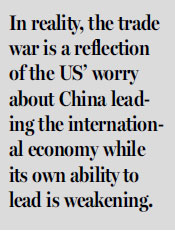US not done yet with protectionism
The US' trade conflict with China is underpinned by deep-rooted thinking based on US President Donald Trump's "America first" policy. However, protectionism and isolationism are not the creation of Trump, but the product of a search for solutions to a host of structural problems that have been continuously intensifying: the hollowing out of the US economy, the flow of manufacturing overseas, an ever-increasing income gap in society, and the inability to break the habit of using government debt to increase fiscal spending are just some of the examples.
Trump's answer to these problems was to withdraw from the Trans-Pacific Partnership agreement, because it "hurts the interests of the American people", renegotiate the North American Free Trade Agreement and US-Republic of Korea Free Trade Agreement, and sign bilateral trade agreements with all countries that are willing to develop trade relations with the US "on the basis of fairness and reciprocity".

The US president has railed against the World Trade Organization and other multilateral institutions, which he claims hurt US interests. He also has abandoned the WTO conflict resolution mechanism, choosing instead to use national security as an excuse to impose sanctions on and take other coercive measures against supposed unfair market practices hurting US interests.















